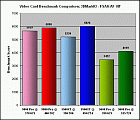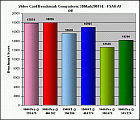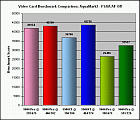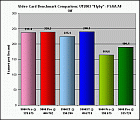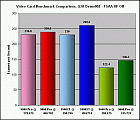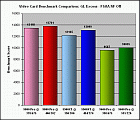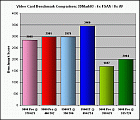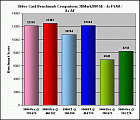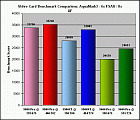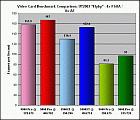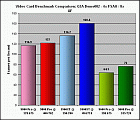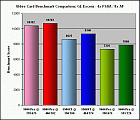| BENCHMARKING RESULTS |
The test data obtained on the three different video cards is summarized in the following table and graphs:
Benchmark Result Summary Table
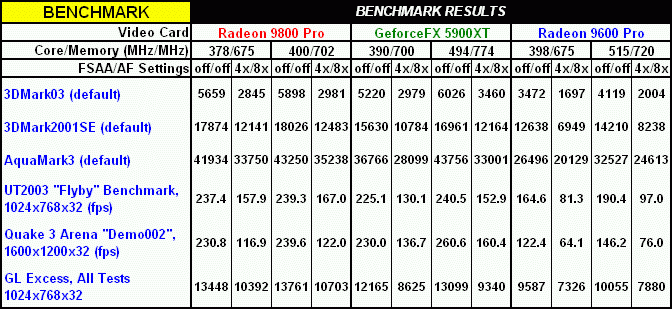
Benchmark Result Charts
(Click on charts to see full size version)
| ANALYSIS & CONCLUSIONS |
It only takes a brief perusal of the data and charts to recognize that Nvidia and MSI have done a very nice job with this 5900XT. Right out of the box, the card's performance is in the same ballpark as the Radeon 9800 Pro and well above the 9600 Pro. And when the clockspeeds are cranked up, the 5900XT closes the gap with the 9800 Pro nicely. Let's take a look at the performance of the card in more detail:
Overall Rendering Speed - At default clockspeeds, the Radeon 9800 Pro is clearly the fastest of the three cards, outrunning the 5900XT by about 8% overall, and the 9600 Pro by 38%. The picture changes significantly when the cards are overclocked, however, because the 5900XT and 9600 Pro both overclock to a significantly greater extent than my 9800 Pro, for reasons previously stated. A "real" 9800 Pro would certainly do somewhat better, though the gain would probably still be less on a proportional basis than the other two cards. The overclocked 5900 XT runs virtually a "dead heat" with the OC'ed 9800 Pro, which is an impressive achievement. Of the twelve benchmarks run in the overclocked condition with these two cards, they each finish first six times, a clean 50-50 split. The overclocked 9600 Pro is still well behind these two cards, at about 32% slower.
Extent of Overclocking - As far as "overclockability" goes, the 5900XT and 9600 Pro were very close overall, with each able to attain an average clockspeed increase of about 18%. For both cards, the core speed could be increased to a significantly greater extent than the memory, which isn't surprising. The 9600 Pro core speed was able to be increased by over 29%, while the 5900XT achieved nearly 27%--both very healthy overclocks! Memory speed increases were 11% and 7% respectively.
As previously indicated, the extent to which my Sapphire Radeon 9800 Pro (actually a non-Pro card, flashed with the Pro BIOS) could be overclocked was significantly less, at 6% for the core and 4% for the memory. Not surprising, since the BIOS flash was basically an overclock of the non-Pro card to begin with. Consequently, this really isn't a fair comparison to the other two cards.
Overclocking Efficiency - As important as how high the clockspeeds can be cranked up is how much performance boost is achieved per MHz of clock frequency increase. In this regard, the 9800 Pro and 5900XT were again neck and neck. Calculating an overclocking "efficiency" number by dividing the mean percentage benchmark score increase by the mean clockspeed percentage increase gave values of about 70% for both cards. What this means is that, for a 10% clockspeed increase, you could expect a 7% overall increase in rendering speed, at least for the six benchmarks used in this study. The 9600 Pro efficiency was somewhat higher at about 92%. This may be because the slower 9600 Pro is more of a video performance bottleneck for the test system than the two faster cards, so a clockspeed increase delivers a bigger proportional performance boost.
Anti-aliasing/Anisotropic Filtering Performance Penalty - It's well known that turning up these two visual quality enhancement parameters--particularly the anti-aliasing--imposes a frame rate penalty in games and benchmarks. For the earliest video cards that offered this feature, it was virtually unusable, because it tended to turn games into "slide shows", even at low resolutions. Happily, things have changed quite a bit, and the performance penalty with these newer cards is much less. Once again, the 9800 Pro and 5900XT were virtually identical in this regard, with both showing a 34% average performance penalty for 4x AA / 8x AF settings. The 9600 Pro was not far behind at 40%. The good result for the 5900XT shows some significant improvement for Nvidia in this area. The last Nvidia card I tested, the 5600 Ultra, showed an alarmingly high 49% performance hit at the same settings.
Image Quality - As well as the 5900XT did in this comparison testing, here's an area where I still have to give the Radeon cards the advantage. Though somewhat subjective, I find both 2D and 3D images to be smoother and more eye-pleasing on the Radeon cards. Colors also look a bit richer to me. One area where the difference is quite evident is at the 4x anti-aliasing setting. For the 5900XT, a slight "stair step" effect is still clearly visible on diagonal lines and edges. For both Radeon cards, diagonals are noticeably smoother, appearing as almost perfectly straight lines. Thus, the AA implementation on the Radeon cards seems to be more efficient in eliminating the dreaded "jaggies".
| THE BOTTOM LINE |
Without a doubt, Nvidia has introduced an excellent 3D card with the GeforceFX 5900XT. Not only is the card's performance within a whisper of the vaunted Radeon 9800 Pro, but the sub-$200 price point where the various brands of 5900XT cards sell makes them an outstanding value for the 3D enthusiast on a budget. The $147 I paid for the refurbished MSI 5900XT-VTD128 card borders on outright larceny! The 5900XT's can legitimately lay claim to the current performance crown for video cards under $200.
The Radeon 9800 Pro still gets my overall nod, but you'll have to pay a bit more for the incremental performance. Still, with 9800 Pro's going for as little as $210 these days (the full 256-bit memory bus version, not the inferior 128-bit card that is also available), the slight price premium isn't too hard to justify.
The Radeon 9600 Pro is still a fine video card and remains a good value under $150. However, its overall performance pales by comparison to the 5900XT and the 9800 Pro. Serious gamers with the financial means will do well to step up to these faster cards. But for the casual gamer looking for a good all-around card at a very reasonable price, the 9600 Pro is a good choice.
|
June 15, 2004
Questions or comments? E-mail me at THIS LINK |
|
